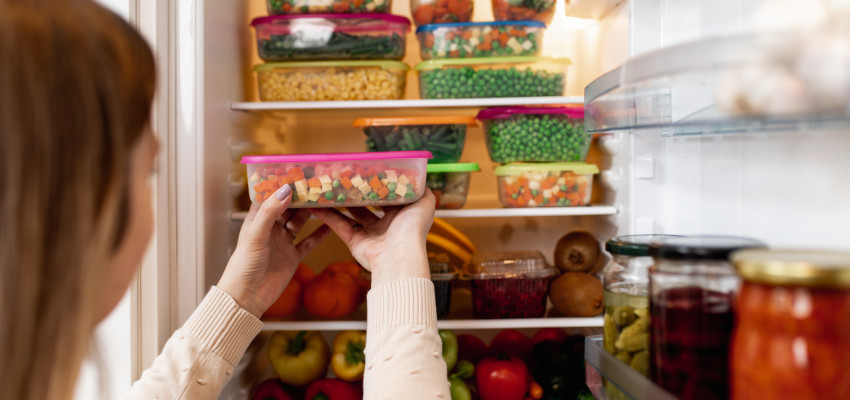By Chef Alli on June 11, 2020
Food Storage Tips

I am always seeking ways to keep food fresh for my family while also reducing food waste. Below are some of my favorite food storage tips that have made a difference in my household.
First Things First: Check the Internal Temp of Your Fridge
To keep your food as fresh as possible, the temperature inside the fridge should register 38-40 F. I purchased an inexpensive clip-on fridge thermometer that I can easily monitor anytime I open the door.
Unpack It
A packed, very full fridge is nice when we want variety and lots of our favorite foods on hand. However, cold air can’t circulate as easily when there’s too much food sitting on every shelf and in every drawer.
To manage this better, we opted to get a second (used) fridge for cumbersome items - boxes of canned soda, bottled water, extra gallons of milk, etc. Such a life saver!
Veggies Going South?
If you’ve got bell peppers and tomatoes that are getting “wrinkle-y” skins, it’s time to make a Rainbow Veggie Frittata. Any vegetables beginning to show signs of softening with age can be chopped and added to an egg frittata or omelet. My favorite frittata veggies include bell peppers, tomatoes, zucchini, spinach, scallions, fresh herbs and red onions. The rainbow of colors makes a beautiful, quick meal with leftovers that reheat well.
“Cut” Right to It - Don’t Delay
The moment we bring vegetables home from the grocer or our local farmer’s market, they are immediately prepped for quick and easy consumption.
When a stomach is grumbling for a snack, it’s a whole lot more likely that we will plunge bell peppers and carrots into hummus when our veggies are ready and waiting in the moment, right in the fridge.
Fruits and Veggies Love Glass Jar Storage
When it comes to certain types of produce, tall glass jars (with lids) in the fridge will become your besties. Strawberries will stay fresher longer, as will patted-dry lettuce leaves when packed into tall jars and covered with a lid. Storing carrots, celery sticks and radishes in a glass jar of water in the fridge keeps them super crunchy.
Scallions placed into a jar of water, root ends down, will stay fresher longer, too. Instead of a lid, the scallions can be loosely covered with plastic wrap or a baggie.
Leaf lettuce and fresh herbs that have been washed and spun or patted dry, also like storage in sealed glass jars.
Celery
And speaking of vegetables in the fridge, have you tried wrapping your stalk of celery in foil? I was skeptical but decided to give it a try. I don’t know the science behind it, only that I’m now a loyal fan because it keeps my celery crisp and fresh for much longer.
Milk
Never store milk in the large pocket-shelves of your refrigerator door, but rather in the main part of your fridge where it stays much cooler, toward the back. Milk kept colder will stay fresher longer. I had no idea that for every 30 minutes a gallon of milk sits outside of refrigeration, it loses one entire day of shelf life.
If you find yourself with a surplus of milk, don’t forget you can freeze it for later use. When freezing milk, remove 1/2 cup of the milk to allow the remainder plenty of room to expand as it freezes in the jug.
If you are limited on freezer space, milk can be placed into freezer bags and frozen flat. Once frozen, the bags of milk can be conveniently stacked on top of each other, or side-by-side. Place the milk in a bowl (in case the freezer bag springs a leak) in your fridge to thaw.
When I have an excess of milk, my family always enjoys a big batch of Instant Pot Homemade Yogurt with Granola.
Cheese
After cutting a block of cheese, rub a bit of softened butter over the cut part to create a barrier that will help keep it fresh.
To freeze shredded cheese for later use, simply shred it, toss with a bit of cornstarch, then store it in a freezer bag. The cornstarch serves as an anti-caking agent that keeps the cheese shreds from clinging to each other as the cheese thaws.
Meat and Poultry
If you’re planning to eat the meat or poultry you’ve just purchased within a day or two, it’s fine to keep it in the original packaging in the fridge. If plans change, wrap the package in heavy-duty aluminum foil, then place inside a freezer bag for storage in the freezer.
Packaged raw meats should always be stored on the bottom shelf of your fridge, placed into a container that can catch and contain any juices that might otherwise escape. This keeps other foods in your fridge safe from cross contamination and bacteria.
Cottage Cheese, Ricotta Cheese, and Sour Cream
Store cottage cheese, sour cream and ricotta cheese containers upside down in the fridge. By inverting these foods, a vacuum is created, helping reduce the chance of mold and bacteria from growing on the surface and the sides of the container. (**This is also a good conversation starter when friends or extended family open your fridge. They will immediately ask what is going on since things do look a bit odd with this storage method.)
Conquering Leftovers
Here’s another way a packed fridge can lead to lots of food waste: leftovers in containers that get pushed to the back, never to be seen or heard from again.
Because I was disgusted to be tossing out so many expired containers of leftovers, I decided to implement a new system: a dry erase board attached directly to the front of our fridge. Each time I place a container of leftovers into the fridge, I make note of it on the dry erase board, also adding the date.
Suddenly, food waste decreased significantly! Thanks to the dry erase board, my family can read at a glance what’s available to grab and reheat before ever opening the fridge.
Avocados
If you’ve purchased avocados that need to ripen, store them at room temperature in a closed paper bag. If you’ve purchased avocados that are already ripened but you can’t eat them right away, stick them in the fridge to hold them off from ripening further.
Tomatoes
When tomatoes are refrigerated, they can turn mealy in texture and bland in flavor. Keeping them at room temperature on the counter allows for stronger, fresher flavors.
When you’ve got a plethora of those delicious home-grown summer tomatoes on your counter, make a big batch of Zesty Shrimp Salsa or Rustic Tomato Pizza Pie.
Garlic and Onions
Garlic and onions will last much longer if stored in an open basket on the counter.
If you have room in your pantry, a hanging mesh laundry bag is ideal for onions and garlic since the mesh allows air to circulate nicely.
Bananas
Did you know bananas stay fresh longer when kept in a bunch? It’s best to separate a banana from the others just prior to when you plan to eat one.
Bananas also stay fresher longer when the crown of the bananas (where they all come together) is wrapped with foil. Even when the exterior of the bananas looks very ripened, you will still find the flesh inside to be quite the opposite.
Store bananas at room temperature until ripened. If the bananas have over-ripened, they can be stockpiled in the freezer until you have enough to make a batch of Glazed Banana Bread or Cherry Banana Muffins.
Apples
Like a few other fruits, apples give off ethylene gas, making them best stored separately. Ethylene gas causes foods to ripen much more quickly than they normally would, which in turn can cause quick decay.
If you are in a hurry to ripen bananas or avocados, placing them into a sealed brown sack with an apple really does the trick.
Apples can also extend the life of potatoes. Store potatoes in a cool dark spot in your pantry with an apple in the bag to help them stay in good condition for up to twice as long.
Try this Rosemary-Sage Sausage and Potato Sheet Pan Dinner! It’s a one-and-done kind of meal your family will really enjoy.
Flour
Freezing flour for 48 hours is sure to kill any insects that may be present. After that, I transfer it to a tightly sealed container, keeping weevils at “bay” by adding a bay leaf.
Brown Sugar
Has your brown sugar gone rock solid? Toss a few large marshmallows into the container to soften it up. The brown sugar will draw moisture from the marshmallows, allowing it to soften once more. (This also works with a slice of bread.)
Salt
Since Kansas is super humid, I’m betting you’ve experienced “clumping” in your salt shaker. Adding a few grains of rice to the salt shaker absorbs the moisture that collects, preventing the salt from sticking together.
Honey
Has your honey crystallized? Don’t be fooled - this doesn’t mean it has spoiled. Cloudiness and crystallization can be taken care of simply by warming your honey. Bring a small saucepan of water to a simmer, then remove from the burner. Add the container of honey to the warm water, letting it slowly warm up; you will see the honey clear up and thin out, ready to use again.
For one of our favorite summer desserts, give these Berry Napoleons with Honey-Glazed Won Ton Wrappers a try.



